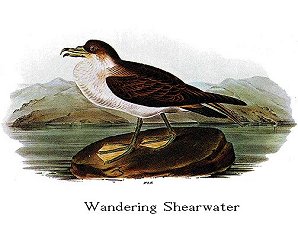
| Family XLIII. PROCELLARINAE. FULMARS. GENUS IV. PUFFINUS, Briss. SHEARWATER. |
Next >> |

Family |
THE WANDERING SHEARWATER. [Greater Shearwater.] |
| Genus | PUFFINUS CINEREUS, Lath. [Puffinus gravis.] |
I have found this species ranging from the Gulf of St. Lawrence to that of
Mexico, but have very seldom seen it near the coast. While sailing round Nova
Scotia, on my way to Labrador, early in June, I observed one evening about
sunset, a great number flying from the rocky shores, which induced me to think
that they bred there. Scarcely one was to be seen during the day, and this
circumstance strengthened my opinion, as I was aware that these birds are in the
habit of remaining about their nests at that time. In September the case is
very different; for they are then seen far out at sea, at all hours by day and
through the night.
In calm weather, they are fond of alighting on the water, in company with
the Fulmars, and are then easily approached. They swim buoyantly, and have a
graceful appearance while playing among themselves. Two that had been caught
with hooks, walked as well as Ducks, and made no pretence of sitting on their
rumps, as some writers have said they do. On being approached, they opened
their bills, raised their feathers, and squirted an oily substance through their
nostrils, which they continued to do when held in the hand, at the same time
scratching with their sharp claws and bills. They refused all sorts of food;
and as they were unpleasant pets, they were set at liberty. To my great
surprise, instead of flying directly off, as I expected, they launched toward
the water, dived several yards obliquely, and on coming to the surface, splashed
and washed themselves for several minutes before they took to wing, when they
flew away with their usual ease and grace.
The flight of this wanderer of the ocean is extremely rapid and protracted.
When it blows hard, it skims along the troughs of the waves on extended wings in
large curves, shewing its upper and lower parts alternately, evidently with the
view of being aided by the wind. In calm weather its flight is much lower and
less rapid, and it rarely throws its body sideways, but seems to feed more
abundantly than during boisterous weather. Like the small Petrels, it
frequently uses its feet to support itself on the surface, without actually
alighting. In the stomach of those which I opened, I found fishes, portions of
crabs, sea-weeds, and oily substances. It does not appear that this species
goes far north, as was formerly supposed; for none of the late northern voyagers
mention having seen it, although they found the Fulmar abundant.
PUFFINUS CINEREUS, Bonap. Syn., p. 370.
CINEREOUS PUFFIN, Nutt. Man., vol. ii. p. 334.
WANDERING SHEARWATER, Puffinus cinereus, Aud. Orn. Biog., vol. iii. p. 555.
Male, 20, 45.
Common off the shores, from the Gulf of St. Lawrence to that of Mexico.
Abundant off Nova Scotia. Ranges to a great distance at sea in autumn and
winter.
Adult Male.
Bill about the same length as the head, rather slender, nearly as deep as
broad at the base, compressed towards the end, slightly curved upwards, with the
tips decurved. Upper mandible with a cere at the base extending narrow to the
nostrils, which are placed above, each covered with a lateral convex plate, and
open anteriorly, with an elliptical aperture; the dorsal line as far as the
nostrils nearly straight, then suddenly deflected, after which it is slightly
concave, but towards the tip incurved, the ridge very broad and convex at the
base, narrower beyond the nostrils, from which a groove proceeds obliquely to
the commencement of the hooked tip; the sides convex and nearly erect, the edges
sharp. Lower mandible with the angle very long and narrow, the dorsal line
beyond it, decurved, the sides sloping outwards, the edges sharp and inflected,
the curved tip grooved above.
Head rather large, oblong, rather compressed. Neck short and stout. Body
moderate, deeper than broad. Wings long. Feet rather large; tibia bare for a
short space below; tarsus of moderate length, compressed, covered all round with
angular scales, the hind ones much smaller; hind toe obsolete, but with a small
conical deflected claw; fore toes long, slender, connected by reticulated webs,
the lateral ones with thin edges; outer toe slightly longer than the third, but
with a shorter claw, the front considerably shorter; toes scutellate above;
claws arched, compressed, acute, that of third toe with an enlarged sharp edge.
Plumage soft, close, blended; on the back compact, the feathers rounded.
Wings very long, pointed; primary quills tapering, the first longest, the second
considerably shorter, the rest rapidly graduated; secondaries short, broad,
obliquely rounded, the inner not elongated. Tail of moderate length, graduated,
of twelve rounded feathers.
Bill yellowish-green, the tips brownish-black, tinged with green. Edges of
eyelids dark grey; iris brown. Feet light greenish-grey, webs and claws
yellowish flesh-colour. The upper parts in general are deep brown, the hind
neck paler and tinged with grey; the primary quills and tail brownish-black.
The lower parts are greyish-white; the lower wing-coverts white, those next the
edge of the wing greyish-black towards the end, the axillary feathers white,
greyish-brown towards the end, lower tail-coverts similar.
Length to end of tail 20 inches, to end of wings 21 1/4, to end of claws
21 1/4; extent of wings 45; wing from flexure 13 1/4; tail 5; bill along the
back 2 4/12, along the edge of lower mandible 2 3/4; tarsus 2 1/4; middle toe
2 1/2, its claw 1/2. Weight 1 lb. 9 3/4 oz.
| Next >> |